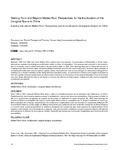Starting From and Beyond Matteo Ricci. Perspectives for the Inculturation of the Liturgical Space in China

Use this link to cite
http://hdl.handle.net/2183/30283
Except where otherwise noted, this item's license is described as Atribución-NoComercial 4.0 Internacional (CC BY-NC 4.0)
Collections
Metadata
Show full item recordTitle
Starting From and Beyond Matteo Ricci. Perspectives for the Inculturation of the Liturgical Space in ChinaAlternative Title(s)
A partir y más allá de Matteo Ricci. Perspectivas para la inculturación del espacio litúrgico en ChinaAuthor(s)
Date
2021-12-22Citation
Leto, F. (2021). Starting From and Beyond Matteo Ricci: Perspectives for the Inculturation of the Liturgical Space in China. Actas de Arquitectura Religiosa Contemporánea, 8, 100-118. https://doi.org/10.17979/aarc.2021.8.0.8854
Abstract
[Abstract] Between 1500 and 1600, the Jesuit Matteo Ricci carried out a true process of inculturation of Christianity in China. Later, other actors operated according to acculturation, which is a form of colonialism. This process also occurred in the construction of churches, most of which were built in the neo-Gothic style. In 1926, Dom Gresnigt was sent to China with the aim of creating a new Sino-Christian style, backed by Bishop Costantini and the new missionary policy. However, these attempts at architectural inculturation only focused on stylistic issues. At present we must act according to an intercultural dialogue that, starting from a textual translation of the liturgical books and ritual action, can provide the architect with images of experience that are capable of being implemented as places and movements on the horizon of the sacred. Metaphors have to be found and even better affordances have to be found to increase the efficacy of ritual actions, making even the merely imaginable emotionally perceptible. [Resumen] Entre 1500 y 1600, el jesuita Matteo Ricci llevó a cabo un verdadero proceso de inculturación del cristianismo en China. Posteriormente, otros actores operaron según la aculturación, que es una forma de colonialismo. Este proceso también se dió en la construcción de iglesias, la mayoría de las cuales se edificaron en estilo neogótico. En 1926, dom Gresnigt fue enviado a China con el objetivo de crear un nuevo estilo chino-cristiano, respaldado por el obispo Costantini y la nueva política misionera. Sin embargo, estos intentos de inculturación arquitectónica sólo se centraron en cuestiones estilísticas. En la actualidad debemos actuar según un diálogo intercultural que, partiendo de una traducción textual de los libros litúrgicos y la acción ritual, pueda proporcionar al arquitecto imágenes de experiencia que sean capaces de implementarse como lugares y movimientos en el horizonte de lo sagrado. Hay que encontrar metáforas e incluso construir mejores affordances para aumentar la eficacia de las acciones rituales, haciendo que incluso las meramente imaginables sean emocionalmente perceptibles.
Keywords
Matteo Ricci
China
Inculturation
Liturgical space
Architecture
Inculturación
Espacio litúrgico
Arquitectura
China
Inculturation
Liturgical space
Architecture
Inculturación
Espacio litúrgico
Arquitectura
Editor version
Rights
Atribución-NoComercial 4.0 Internacional (CC BY-NC 4.0)
ISSN
2659-8671






